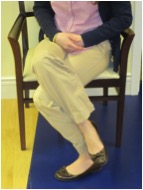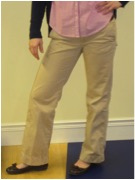Are you a half ass? – stretch weakness of gluteal muscles contributing to heel, foot, shin, knee, hip pain

There is a growing body of evidence that many repetitive use injuries such as knee pain, shin pain, heel pain, and forefoot pain can be addressed by improving the strength of the gluteal muscles. The gluteal muscles consist of gluteus maximus, gluteus medius, gluteus minimus, piriformis, and smaller less recognized muscles are commonly called “bun muscles, booty, or ass muscles”.
Signs of weakness of the gluteal muscles that can be observed when walking or running include a leaning or listing of the trunk to the side, excessive movement of the pelvis, knees knocking, excessive inward rotation of the thigh/leg, and excessive pronation of the foot.
A frequent problem is to have gluteal muscles on one side of the body significantly weaker compared to the other side. If gluteal muscles on one side of the body are weaker, they will appear smaller and feel softer or less toned. Having one group of gluteal muscles that is weaker can be described as appearing “half assed”.
In the absence of a metabolic or neurological disease the question arises why gluteal muscles would be smaller and weaker on just one side of the body. There is a physiological phenomenon described as “stretch weakness” or muscle length associated weakness. Comparing a muscle of normal length against a muscle which is longer than normal length, the longer muscle cannot generate as much force when the muscle is a shortened position.
Metal springs on a screen door can be used an analogy. Each gluteal muscle is a metal spring, the same gauge of metal, same length, same number of coils, and same space between each coil. Over a period of time if the left gluteal spring is stretched too much the space between the coils will increase. This spring is not as strong when it comes to closing the screen door all of the way.
Habitual asymmetrical postures or positions which can result in gluteal muscles being overstretched and too long are many. The following are three common postures and which would chronically stretch the left gluteal muscles.
Figure 1: sitting with left leg medially rotated and crossing the mid-line of the body and the weight of the right leg is adding intensity to the chronic stretch of the left gluteal muscles.

Figure 2: Standing with majority of the weight on the left leg, the left leg medially rotated leading to chronic stretching of the left gluteal muscles.

Figure 3: Lying on the right side with left leg crossing the mid-line for several hours when sleeping leading to chronic stretching of the left gluteal muscles.

Because of hand dominance individuals will likely do one posture more frequently than the other. For example young right handed mothers will likely carry their child on the left hip and rarely carry the child on the right hip.
There are two steps to correcting a muscle “stretch weakness” stop stretching the muscle and perform exercises to strengthen and stiffen the muscle. There are two steps to stopping the habitual asymmetrical postures, first recognize the posture and secondly don’t do it. The first step of recognizing the habitual asymmetrical posture is the tougher step, so ask for help. Ask significant others to point out to you that you are crossing your legs in a bad way. If hip stretching exercise is part of your normal exercise routine, stop doing stretching exercises for the hip.
A search of the internet can show a number of exercises designed to strengthen the gluteal muscles. The challenge is to identify exercises which focus on one side of the body. Symmetrical exercises like a squat will strength the strong short gluteal muscle and the long weak gluteal muscle. The effect is both the relatively strong and weak muscle group gets stronger, but the weaker group of muscles does not catch up to the strong group. The challenge is to modify the exercise to provide enough assistance to complete the range of motion. When the metal spring on a screen door is stretched out a little push or pull is needed to close the screen door all of the way. The final step is gait re-training to re-learn how to engage the gluteal muscle demonstrating stretch weakness to eliminate the previously observed listing of the trunk to the side, excessive movement of the pelvis, knees knocking, excessive inward rotation of the thigh/leg, and excessive pronation of the foot.
In you are a half ass and want to become a complete ass avoid or minimize habitual asymmetrical postures and positions which chronically stretch the gluteal muscles.
Damien Howell Physical Therapy – 804-647-9499 – Fax: 866-879-8591 At-Home, At Office, At Fitness Facility – I come to you, I do home visits Damien@damienhowellpt.com
